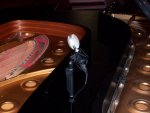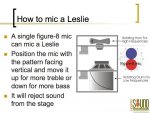I'm now 29 shows down and 7 to go in my annual marathon Summer run at the Stanford Jazz Workshop and Festival.
It's a jazz camp and the concerts are done by the faculty who are mostly well know jazz musicians.
I mix all of the concerts and simultaneously make archival recordings
2012 Stanford Jazz Festival lineup announced - News - Stanford Jazz Workshop
Most of the concerts are piano, bass and drums trios with one to four horn soloists down front with the occasional guitar or vibes player. But with the pool of available talent, last minute additions and surprises are not uncommon.
But last Thursday in the venue that has a limited number of inputs , the show expanded to include a total of 16 musicians including a percussionist who's required multiple microphones And TWO 9 foot grand pianos.
This made my usual two or three mic setup on one piano not an option.
SO, after seeing the way they wanted to set up on stage, finding out who the drummers were and weighing my options I did THIS.
One, figure 8 pattern Cascade Fathead ribbon between the two pianos; Hamburg Steinway with the lid off in front and New York Steinway in back with the lid on full stick. A little tweaking of the angle of the back pickup side of the mic towards the lid of the back piano and the balance was good when both pianos were played.
And the rejection of sounds coming from the rest of the stage, including the drums, was remarkable.
It's a jazz camp and the concerts are done by the faculty who are mostly well know jazz musicians.
I mix all of the concerts and simultaneously make archival recordings
2012 Stanford Jazz Festival lineup announced - News - Stanford Jazz Workshop
Most of the concerts are piano, bass and drums trios with one to four horn soloists down front with the occasional guitar or vibes player. But with the pool of available talent, last minute additions and surprises are not uncommon.
But last Thursday in the venue that has a limited number of inputs , the show expanded to include a total of 16 musicians including a percussionist who's required multiple microphones And TWO 9 foot grand pianos.
This made my usual two or three mic setup on one piano not an option.
SO, after seeing the way they wanted to set up on stage, finding out who the drummers were and weighing my options I did THIS.
One, figure 8 pattern Cascade Fathead ribbon between the two pianos; Hamburg Steinway with the lid off in front and New York Steinway in back with the lid on full stick. A little tweaking of the angle of the back pickup side of the mic towards the lid of the back piano and the balance was good when both pianos were played.
And the rejection of sounds coming from the rest of the stage, including the drums, was remarkable.
Attachments
Last edited:



